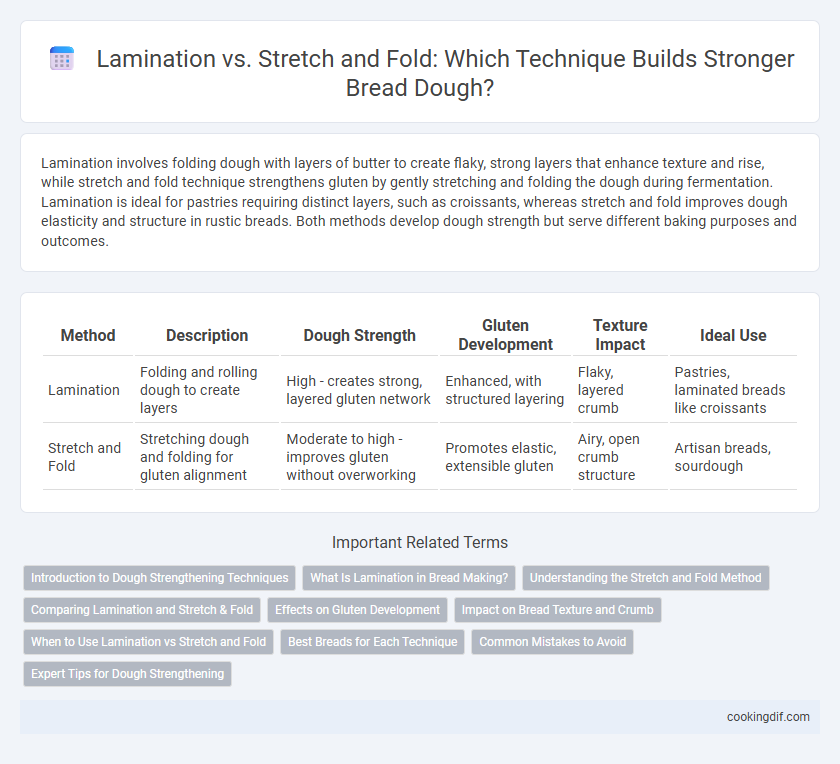Lamination involves folding dough with layers of butter to create flaky, strong layers that enhance texture and rise, while stretch and fold technique strengthens gluten by gently stretching and folding the dough during fermentation. Lamination is ideal for pastries requiring distinct layers, such as croissants, whereas stretch and fold improves dough elasticity and structure in rustic breads. Both methods develop dough strength but serve different baking purposes and outcomes.
Table of Comparison
| Method | Description | Dough Strength | Gluten Development | Texture Impact | Ideal Use |
|---|---|---|---|---|---|
| Lamination | Folding and rolling dough to create layers | High - creates strong, layered gluten network | Enhanced, with structured layering | Flaky, layered crumb | Pastries, laminated breads like croissants |
| Stretch and Fold | Stretching dough and folding for gluten alignment | Moderate to high - improves gluten without overworking | Promotes elastic, extensible gluten | Airy, open crumb structure | Artisan breads, sourdough |
Introduction to Dough Strengthening Techniques
Lamination involves repeatedly folding and rolling dough with layers of fat that create a structured, flaky texture, enhancing dough strength by developing gluten and improving extensibility. Stretch and fold is a technique where the dough is gently stretched and folded to align gluten strands, increasing dough elasticity and gas retention without the use of added fats. Both methods improve dough strength and structure, critical for producing artisan breads with desirable crumb and volume.
What Is Lamination in Bread Making?
Lamination in bread making involves folding layers of dough and fat, such as butter, to create a flaky, airy crumb structure typical in pastries and certain breads like croissants. This technique enhances dough strength by evenly distributing fat, which impacts gluten development differently than stretch and fold, a method that involves gently stretching and folding the dough to improve elasticity and gas retention. Lamination produces distinct layers and a tender texture, while stretch and fold primarily strengthen the dough's gluten network for better rise and chewiness.
Understanding the Stretch and Fold Method
The stretch and fold method enhances dough strength by gently developing gluten networks through periodic stretching and folding during fermentation, promoting better gas retention and crumb structure. Unlike lamination, which involves layering dough with fat to create flaky textures, stretch and fold maintains dough hydration and elasticity without incorporating additional ingredients. This technique is essential for high-hydration doughs, improving volume and crumb resilience while requiring minimal equipment.
Comparing Lamination and Stretch & Fold
Lamination and stretch and fold techniques both enhance dough strength but achieve it differently: lamination creates multiple thin layers of dough and fat, improving structure and flakiness, ideal for laminated breads like croissants; stretch and fold builds gluten networks through gentle stretching and folding during fermentation, increasing dough elasticity and gas retention, suitable for rustic loaves. Lamination requires careful temperature control to maintain butter consistency, while stretch and fold is simpler and less time-sensitive, making it accessible for a wide range of bread types. Choosing between lamination and stretch and fold depends on desired crumb texture and bread style, with lamination yielding delicate layers and stretch and fold promoting a chewy, open crumb.
Effects on Gluten Development
Lamination enhances gluten development by repeatedly folding and rolling the dough, creating distinct layers that improve dough strength and elasticity. Stretch and fold techniques promote gluten alignment and gas retention through gentle, periodic stretching, leading to enhanced dough structure without overworking. Both methods increase gluten network stability, but lamination results in a more uniform, elastic crumb, while stretch and fold deliver a more open, airy texture.
Impact on Bread Texture and Crumb
Lamination creates distinct, layered dough structures that result in a flaky and airy bread texture, while stretch and fold techniques develop gluten strength more gradually, producing a more open and irregular crumb. The lamination process traps thin layers of fat within the dough, contributing to a tender, crisp crust and a delicate, flaky crumb, typical of croissants and puff pastries. Stretch and fold methods enhance dough elasticity and gas retention, leading to a chewy, robust crumb with uneven holes, ideal for artisan sourdough and rustic loaves.
When to Use Lamination vs Stretch and Fold
Lamination is ideal for high-hydration doughs requiring delicate layering, such as croissants and puff pastry, to create a tender, flaky crumb with enhanced dough strength. Stretch and fold techniques suit leaner or bulkier bread doughs needing gluten development without degassing, promoting structure and elasticity during fermentation. Use lamination when layering fat within dough, and stretch and fold for reinforcing gluten in artisan bread or sourdough batters.
Best Breads for Each Technique
Lamination produces layered, flaky textures ideal for croissants and puff pastries, providing superior dough strength and lift through repeated folding and rolling. Stretch and fold enhances gluten development and dough elasticity, making it perfect for artisan breads like sourdough and ciabatta with open crumb structures. Each method optimizes dough strength differently, aligning lamination with delicate laminated pastries and stretch and fold with rustic artisan loaves.
Common Mistakes to Avoid
Over-laminating dough can lead to excessive gluten development, resulting in a tough texture, while under-laminating fails to create the necessary layers for a flaky crumb. Stretch and fold techniques must be timed correctly; performing them too frequently or too vigorously risks tearing the dough's gluten network, weakening its structure. Avoid neglecting dough resting periods, as insufficient relaxation causes resistance during shaping and limits dough strength enhancement.
Expert Tips for Dough Strengthening
Lamination technique enhances dough strength by creating multiple thin layers of fat and dough, resulting in superior gluten development and a flakier texture ideal for laminated breads like croissants. Stretch and fold method improves dough structure through gentle gluten alignment and aeration without deflating the dough, perfect for artisan loaves requiring open crumb and chewiness. Expert bakers recommend combining precise lamination for enriched dough strength with periodic stretch and folds during bulk fermentation to maximize gas retention and dough elasticity.
Lamination vs stretch and fold for dough strength Infographic

 cookingdif.com
cookingdif.com